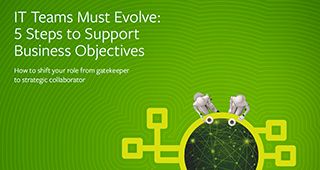Today, traditional organizations struggle to embrace technologies that compromise control of sensitive business processes and systems. For example, cloud computing and enterprise mobility offer promising ways to scale business and improve employee productivity, yet they may raise uncertainty around likely future scenarios that impact mission-critical business decisions.
Because of this concern, many companies are rolling out digital transformation initiatives at a slow, careful pace—but that concern may put you behind more progressive competitors that have successfully embraced digital transformation despite the inherent risks and limitations.
In 2014, Gartner introduced the concept of bimodal IT as one strategy to take advantage of digital transformation in context of these challenges. Defined as “the practice of managing two separate styles of work—one focused on predictability and the other on exploration”, bimodal IT identifies Mode 1 and Mode 2 as two distinct but complementary ways to manage an IT project.
In this article, we will explore the differences between the characteristics and application use cases of Mode 1 and Mode 2 IT strategies.
Two modes of IT
Both Mode 1 and Mode 2 allow the development and delivery of IT services in different ways:
- Mode 1 refers to a linear and predictable approach to change. The focus is to ensure reliable, accurate, and stable IT projects that are also suitable for the digital world.
- Mode 2 refers to an exploratory and experimental approach to change. The focus is to optimize for uncertain situations and maximize the value potential of digital transformation initiatives.
The essence of Bimodal IT strategy lies in coherent adoption of Mode 1 and Mode 2 IT practices that will transform appropriate business process for digital transformation, optimizing the overall risk and reward for the organization. The differences between Mode 1 and Mode 2 IT strategies can be categorized in the following domains
- Goal. The goal of Mode 1 IT is to produce reliable IT functions and service delivery in the digital world. Mode 2 IT focuses on agility and speed throughout the SDLC pipeline.
- Value. Mode 1 IT evaluates the value of a project based on the cost incurred to achieve the result. Mode 2 IT evaluates the performance based on improvements in customer experience, brand reputation, and revenue.
- Approach. Mode 1 follows traditional ITSM frameworks such as Waterfall with the purpose to deliver a complete project. Mode 2 follows iterative development and delivery methodologies such as DevOps. Each release cycle produces small but frequent functional improvements.
- Governance. Mode 1 projects follow a stringent governance strategy with careful review, pre-approval and plan-driven project execution. Mode 2 follows the principles of continuous improvement through experimentation. The results are less predictable in Mode 2 but the delivery cycle follows a continuous feedback process to improve successive release iterations.
- Sourcing. Mode 1 requires sourcing from well-reputed enterprise vendors following long-term deals for reliable, continuous and predictable supply of resources. Mode 2 allows sourcing from startup firms on short-term deals on resources that may not be widely adopted in the market.
- Talent. Mode 1 requires seasoned professionals accomplished in executing conventional projects in legacy IT environments. Mode 2 requires talent skilled in new technologies and uncertain projects, capable of producing effective new solutions to unforeseen challenges.
- Culture. Mode 1 is focused on backend IT processes and operations, often decoupled from end-users beyond the corporate IT network. Mode 2 is focused toward business outcomes that depend on customer experience, brand image and growth potential.
- Cycle times. Mode 1 projects can take long time for execution, since the expected is a complete working version of the project. Mode 2 projects follow rapid release sprints that may span from a few days to a few weeks. The output may be a Minimal Viable Product (MVP) representing the idea of a fully functional working product planned for long-term development.
- Pace layers. Gartner defines Pace-Layered Application Strategies to categorized different IT projects. Mode 1 strategies are adopted for the System of Records pace layer, which includes legacy systems supporting core business processes. Examples include payment transaction or management of critical master databases. Mode 2 strategies are adopted for the Systems of Innovation pace layer. This includes applications developed to exploit new business opportunities or customer-centric feature improvements.
Business-IT alignment of multi-modal IT
Many organizations pursuing digital transformation may have adopted Mode 1 or Mode 2 strategies. Large enterprises often default to Mode 1 practices in order to support long-term technology-driven goals involving predictable, repetitive, and sensitive tasks. SMBs, however, may opt for Mode 2 practices that rely on cloud-driven business processes.
Instead of debating the appropriate mode, the more accurate question is the viability of coherent Mode 1 and Mode 2 IT strategies. This two-category system has gained limited traction in the enterprise IT segment and is seen as counterproductive for many digital transformation applications. Such a system may add to your overall complexity, as both modes aim to achieve conflicting goals while competing for limited resources within the same organization. Both modes are inherently technology-centered with limited customer-focused attention. In contrast, the digital transformation philosophy encourages business organizations to take advantage of digital technologies with the perspective of improving customer experience, thereby yielding positive business outcomes.
The bimodal IT strategy also suggests that legacy systems can be maintained over the long term. In reality, legacy systems require constant re-engineering to meet the security, performance, and reliability requirements of the business. A multi-modal IT system causes further divide in the organizational culture due to its support for coherent adoption of monolithic, siloed, and disconnected IT service management and delivery frameworks.
The solution for many organizations pursuing digital transformation strategies may lie in evaluating your business requirements and customer expectations as the key drivers to digital transformation efforts. Modern ITSM framework including Agile and DevOps already provide guidelines to optimize these initiatives with a customer-centric approach. The underlying principles help organizations apply Mode 2 IT principles for business processes that previously relied on Mode 1 legacy systems. The result is alignment of business and IT, which may not be possible in a bimodal IT framework.
Additional resources







